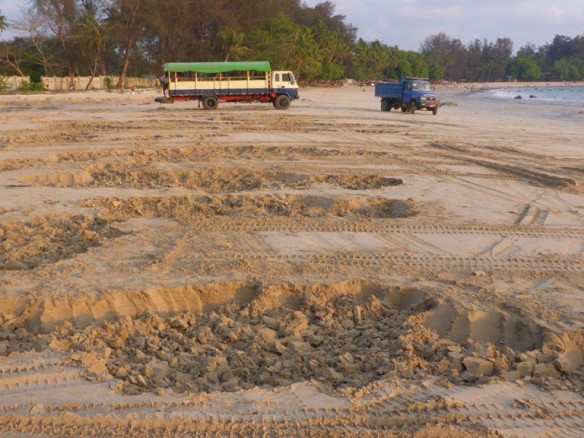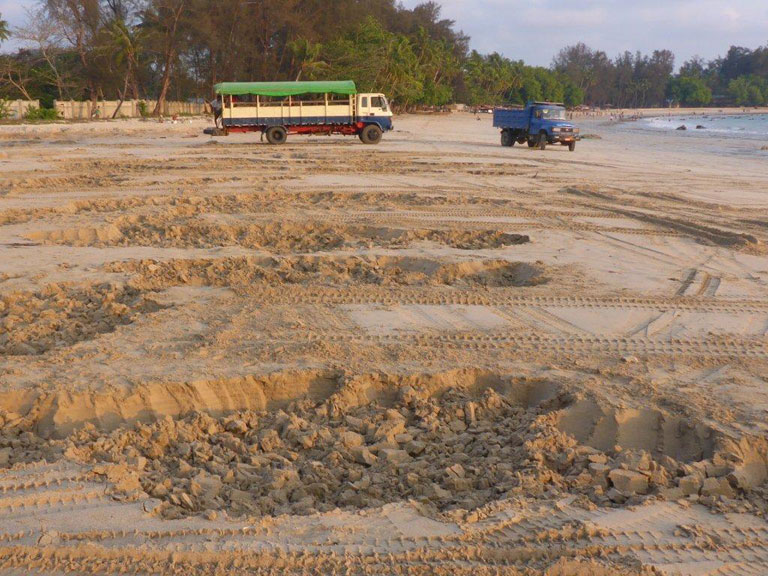
Ngapali Beach sand mining, Myanmar. Photo courtesy of: © Oliver E Soe Thet
Excerpts;
Farmers and politicians in Chaungzon township, worry that erosion in the area is being exacerbated by the ships that dredge its bed for sand each night. The sand is mainly bound for Singapore, the world’s biggest importer, for use in reclamation and construction projects.
Both the Myanmar government and the company whose ships do the dredging in Chaungzon, deny the dredging is causing the erosion.
The dispute highlights the fractious issue of sand-mining in Southeast Asia as Singapore is forced to look farther afield to slake its thirst for sand following bans on the trade in countries like Malaysia and Indonesia over environmental concerns…
Read Full Article, Reuters (03-04-2020)
Myanmar: “Our land is collapsing around us”: population and environment at risk from rampant sand mining; Frontier Myanmar (01-16-2019)
Irresponsible sand mining in the Ayeyarwady River is destroying the livelihoods of farmers and fishers and placing environmental stress on the nation’s rice bowl…
Paradise Lost? Beach sand mining, Ngapali beach, Myanmar, A dossier and photo reportage by Oliver Soe Thet (12-13-2015)
Twenty years ago Ngapali Beach, on the Bay of Bengal, was an unspoilt gem in the crown of Myanmar’s natural treasures. Times have changed. Beach sand mining at Ngapali, has disturbed the natural balance…
Grain by Grain, Truck by Truck: How Myanmar Is Losing its Beaches; Earth Island Journal (02-14-2016)
Around every corner waits a new truck. Workers dig their shovels into the powdery white sand of Myanmar’s Ngapali beach, the country’s top seaside destination, and lift it onto the truck beds. Vast craters dot the coastline…
Built on Sand: Singapore and the New State of Risk; Harvard Design Magazine (09-07-2015)
The island’s expansion has been a colossal undertaking. It is not merely a matter of coastal reclamation: Singapore is growing vertically as well as horizontally. This means that the nation’s market needs fine river sand—used for beaches and concrete—as well as coarse sea sand to create new ground…
How Singapore is creating more land for itself; The New York Times (04-20-2017)
The island off the southern tip of Malaysia reveals the future of building in an epoch of dwindling territory…
Sand: the new gold; Les Echos (02-2018)
This is one of the most consumed natural resources in the world. In cambodia, its mining as lead to an environmental catastrophe, while in singapore sand has contributed to 24% of the island’s expansion…
Such Quantities of Sand, The Economist (07-27-2015)
Asia’s mania for reclaiming land from the sea spawns mounting problems…
Singapore’s data mirrors UN’s on Cambodia’s sand export numbers; The Phon Penh Post (10-19-2016)
Singaporean customs data on sand imports from Cambodia show near identical figures to those recorded by the UN, which last month were dismissed by a top official amid a reporting discrepancy in the hundreds of millions of dollars. The UN data showed $752 million in imports of sand from Cambodia since 2007, despite Cambodia reporting only about $5 million in exports to Singapore…
Sand Storm: $750 Million Worth of The Material is Unaccounted For in Cambodia; RFA (11-02-2016)
Nearly 50 civil society organizations called for the Cambodian government to join some other Southeast Asian nations and ban or severely restrict exports of sand to Singapore after it was revealed that nearly $750 million worth of the building material has disappeared from the country…
In Cambodia, sand mining is big business — but it comes at a price; PBS (09-18-2019)
Sand mining accounts for 85 percent of all worldwide mineral extraction, a $70 billion industry. In Cambodia, the practice is big business — but it comes with a price. Special correspondent Fred de Sam Lazaro reports…
Cities from the sea: the true cost of reclaimed land; Guardian UK (05-02-2018)
Asia is growing. Literally. From Malaysia to Dubai, luxury developments are rising on artificial islands and coastlines. Everybody wins – except the local sea life and the fishermen who depend on it…
Sand, Rarer Than One Thinks: A UNEP report (GEA-March 2014)
Despite the colossal quantities of sand and gravel being used, our increasing dependence on them and the significant impact that their extraction has on the environment, this issue has been mostly ignored by policy makers and remains largely unknown by the general public.
In March 2014 The United Nations released its first Report about sand mining. “Sand Wars” film documentary by Denis Delestrac – first broadcasted on the european Arte Channel, May 28th, 2013, where it became the highest rated documentary for 2013 – expressly inspired the United Nations Environment Programme (UNEP) to publish this 2014-Global Environmental Alert.
Demand for sand: the largest mining industry no one talks about; Inhabitat (05-23-2019)
The world’s largest and perhaps most destructive mining industry is rarely discussed. Approximately 85 percent of all material mined from the earth is a simple and widely available resource: sand. Because it is so cheap and readily available, it is mined by everyone from guy with a shovel, to multi-million dollar machine operations.
The Conservation Crisis No One Is Talking About, TakePart (09-21-2016)
Beaches around the world are disappearing. No, the cause isn’t sea-level rise, at least not this time. It’s a little-known but enormous industry called sand mining, which every year sucks up billions of tons of sand from beaches, ocean floors, and rivers to make everything from concrete to microchips to toothpaste…
Sand Wars, An Investigation Documentary, By Multi-Award-Winning Filmmaker Denis Delestrac (©2013)
Sand is the second most consumed natural resource, after water. The construction-building industry is by far the largest consumer of this finite resource. The traditional building of one average-sized house requires 200 tons of sand; a hospital requires 3,000 tons of sand; each kilometer of highway built requires 30,000 tons of sand… A nuclear plant, a staggering 12 million tons of sand…









